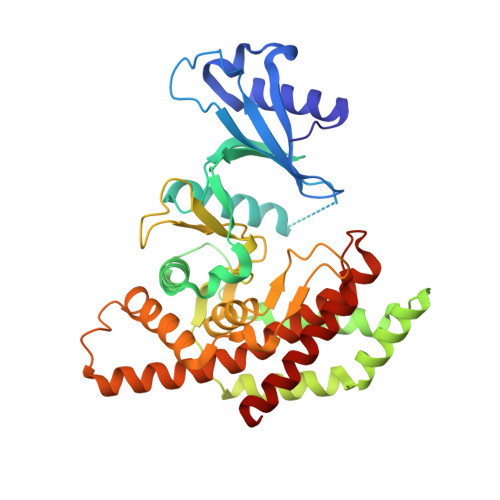Pharmacophore-Based Virtual Screening to Discover New Active Compounds for Human Choline Kinase Alpha1
Serran-Aguilera, L., Nuti, R., Lopez-Cara, L.C., Gallo Mezo, M.A., Macchiarulo, A., Entrena, A., Hurtado-Guerrero, R.(2015) Mol Inform 34: 458
- PubMed: 27490389
- DOI: https://doi.org/10.1002/minf.201400140
- Primary Citation of Related Structures:
5AFV - PubMed Abstract:
Choline kinase (CK) catalyses the transfer of the ATP γ-phosphate to choline to generate phosphocholine and ADP in the presence of magnesium leading to the synthesis of phosphatidylcholine. Of the three isoforms of CK described in humans, only the α isoforms (HsCKα) are strongly associated with cancer and have been validated as drug targets to treat this disease. Over the years, a large number of Hemicholinium-3 (HC-3)-based HsCKα biscationic inhibitors have been developed though the relevant common features important for the biological function have not been defined. Here, selecting a large number of previous HC-3-based inhibitors, we discover through computational studies a pharmacophore model formed by five moieties that are included in the 1-benzyl-4-(N-methylaniline)pyridinium fragment. Using a pharmacophore-guided virtual screening, we then identified 6 molecules that showed binding affinities in the low μM range to HsCKα1. Finally, protein crystallization studies suggested that one of these molecules is bound to the choline and ATP-binding sites. In conclusion, we have developed a pharmacophore model that not only allowed us to dissect the structural important features of the previous HC-3 derivatives, but also enabled the identification of novel chemical tools with good ligand efficiencies to investigate the biological functions of HsCKα1.
- Department of Pharmaceutical and Organic Chemistry, Faculty of Pharmacy, University of Granada, Campus Cartuja, Granada 18071, Spain phone: +34 958 243848.
Organizational Affiliation:


















